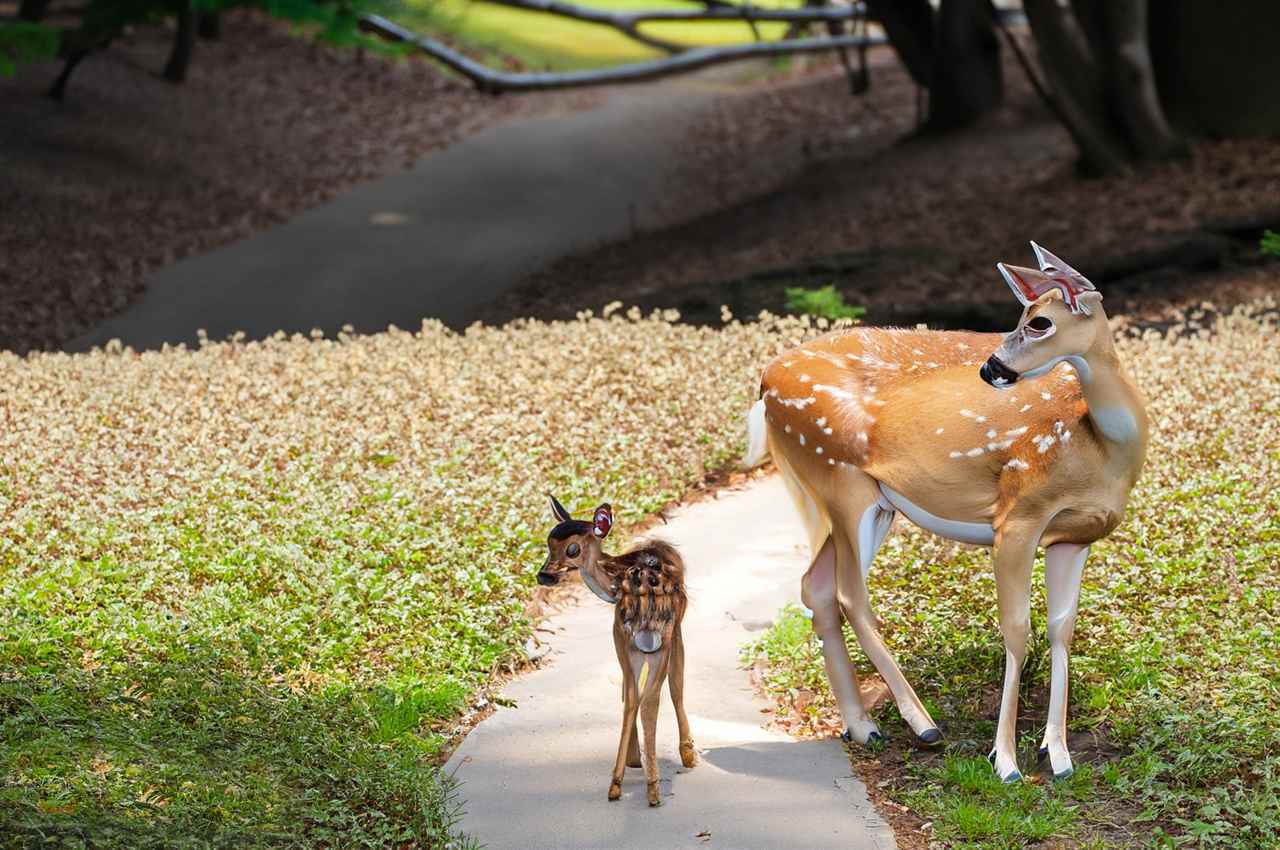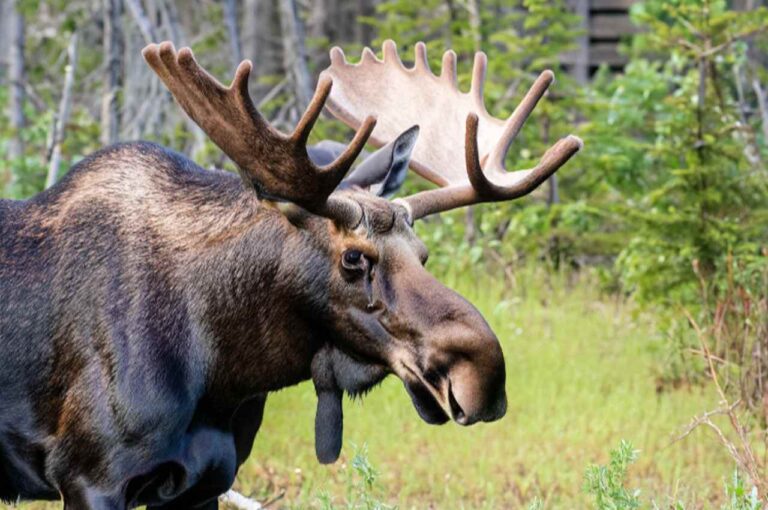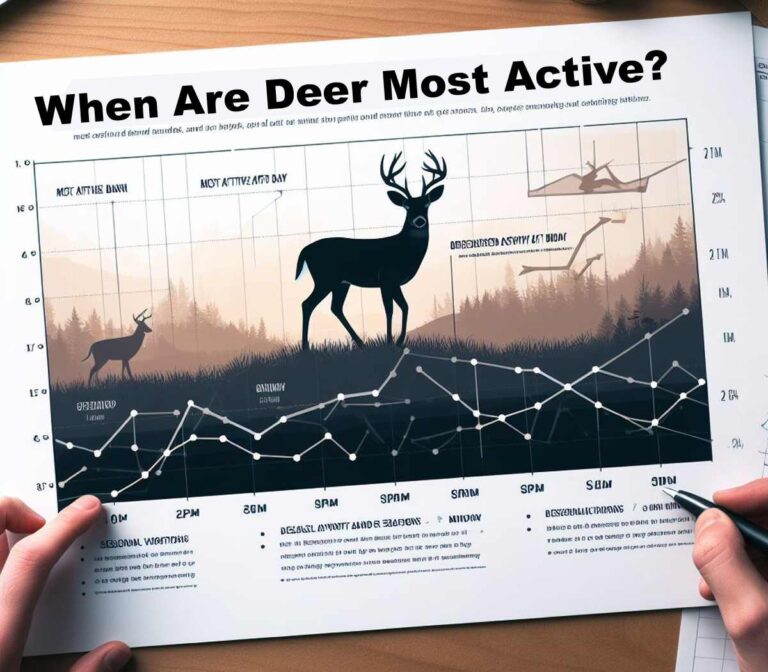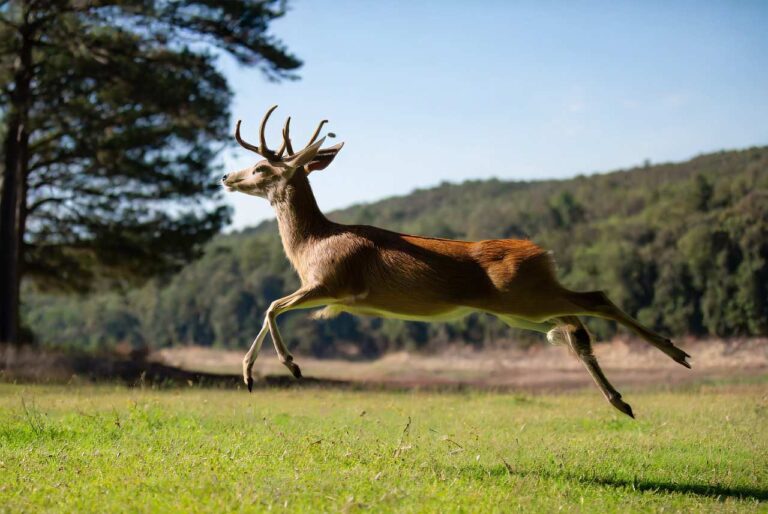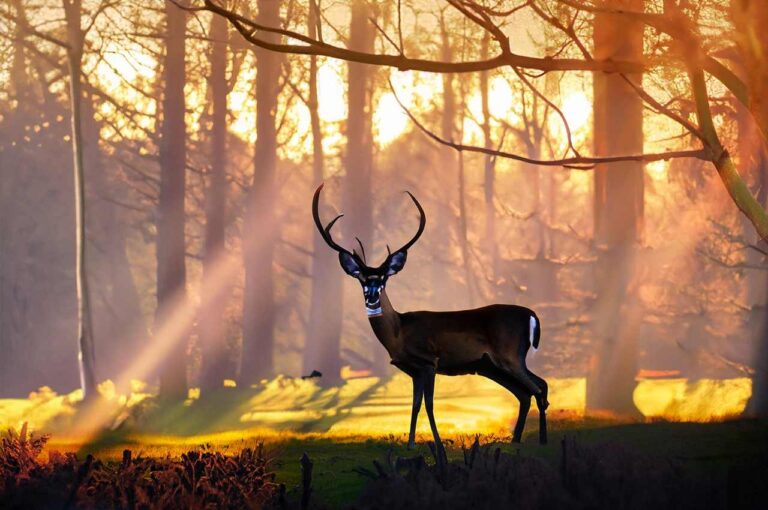How Does A Mother Deer Find Her Fawn?
The close relationship that exists between animal mothers and their young is one of nature’s most amazing things. In deer, this innate bond is particularly remarkable. A doe may conceal her fawn in thick grass or shrubs shortly after giving birth and leave it alone for extended periods of time. But every time she comes back, she always finds her fawn. This raises the question – how does a mother deer find her fawn?
How does a mother deer find her fawn?
The doe remembers where she left her fawn by making a note of it. Deer have exceptional spatial memory and often remember exactly where their concealed fawn is. However, if the doe transfers her fawn to a different area, the hiding place could change. To locate their fawns, mothers of deer use a number of techniques, such as:
- Sight: Around two weeks old, the deer will begin to “flush” when disturbed, scurrying to a new hiding spot close by. If the doe cannot locate the fawn in its initial location, she will visually investigate the surrounding region. The way a fawn moves may also help a mother deer identify it as hers.
- Sound: Fawn mothers do summon their hiding calves with grunts and bleats. The fawn will respond with a bleat of its own when it hears its mother’s voice. Fawns do not, however, have a distinctive scream that allows their mother to recognize them.
- Scent: Deer possess a keen sense of smell. Instead of looking for the fawn’s smell, does hunt for their own fragrance. Where she shelters the fawn, a doe leaves her smell behind. Fawns begin emitting their own smell between 7 and 10 days of age, which also aids the doe in locating them.
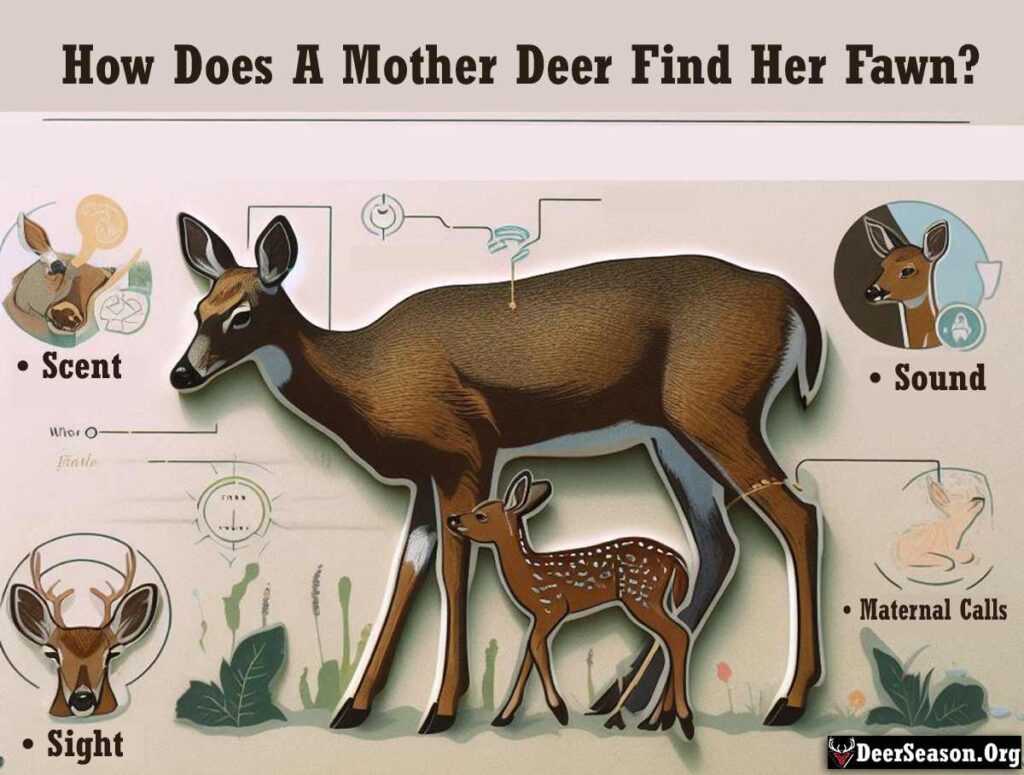
A fawn will normally remain in one spot and bleat to summon its mother if it becomes lost or separated from her. The mother deer will hear the fawn bleat and hunt for it by following the sound.
A mother deer could sometimes be unable to locate her offspring. This may occur if the fawn is wounded or ill, or if it spends a lengthy time away from its mother. A mother deer may finally give up and leave her young if she can’t locate it.
Methods of Communication Used by Mother Deer
| Method of Communication | Description |
|---|---|
| Chemical Communication | Mother deer use their sense of smell to locate their fawns, searching for their own scent in the hiding place. |
| Sight | When the fawn is older, they can recognize each other's motions and looks by using visual clues. |
| Maternal Calls | Mother deer may grunt and bleat to their young, and the fawn may answer with its own bleat. Female deer have distinct calls that fawns can identify. |
| Visual Investigation | The mother visually scans the area to find the fawn if it is transferred to a new hiding place. |
| Body Language | Deer can recognize their young by observing their movements and habits. |
| Strong Bond | The mother and fawn have a strong maternal attachment that keeps them linked even while they are apart. |
| Fawn's Unique Scent | Between 7 and 10 days of age, fawns start to emit their own distinctive fragrance, which helps with identification. |
| Fawn's Bleating | When a fawn is lost or separated, it often remains there and bleats, which enables its mother to follow the sound. |
| Challenges | In other instances, the mother may not be able to find the fawn if it is hurt, sick, or spends a lot of time away. |
| Giving Up | The mother deer may finally give up if she is unsuccessful in finding her young after a prolonged search. |
| Remarkable Bond | These means of interaction and navigation underline the exceptional relationship that exists between mother and fawn in the animal realm. |
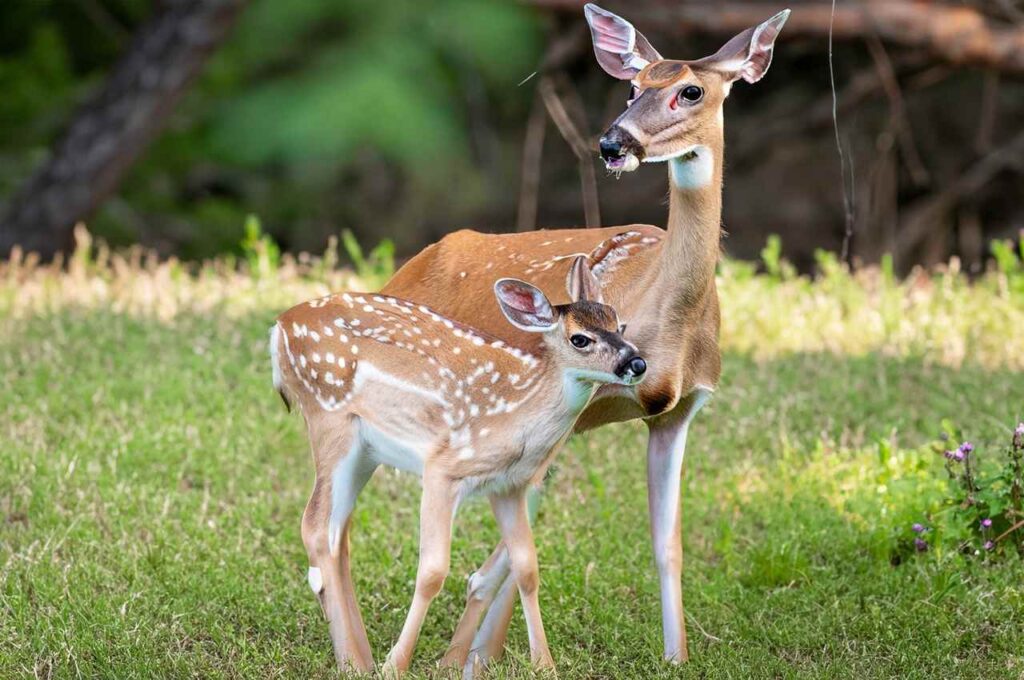
Other Factors That Help the Bond
Other elements play a role in how a doe recognizes and bonds with her fawn, including:
- Birth location – Does give birth outside of the herd where there won’t be any other fawns around. Finding her own newborn is now easier as a result.
- Lack of herd scent – Newborn fawns do not yet have the scent of the herd. The doe can tell that her fawn is her own when she smells it for herself.
- Familiar features – Over time, the doe learns to identify characteristics of her fawn’s voice, behavior, and look. The more time they spend together, the more comfortable they get.
Survival Factors for Fawns Without Mothers
| Factor | Description |
|---|---|
| Age of Fawn | Fawns that are 45 to 60 days old or older have a greater chance of surviving without their moms. |
| Food and Water | For fawns to thrive on their own, there must be enough food and water available. |
| Predators and Threats | When fawns are separated from their moms, they are more susceptible to predators and other dangers. |
Fawns are Hidden for Protection
A doe cleans her fawn after delivery and eats the leftovers to get rid of any smell that could attract predators. She will bury the fawn in foliage and often leave it alone all day. This is due to fawns’ inability to get away from predators with enough speed and energy. Their only defense is to hide.
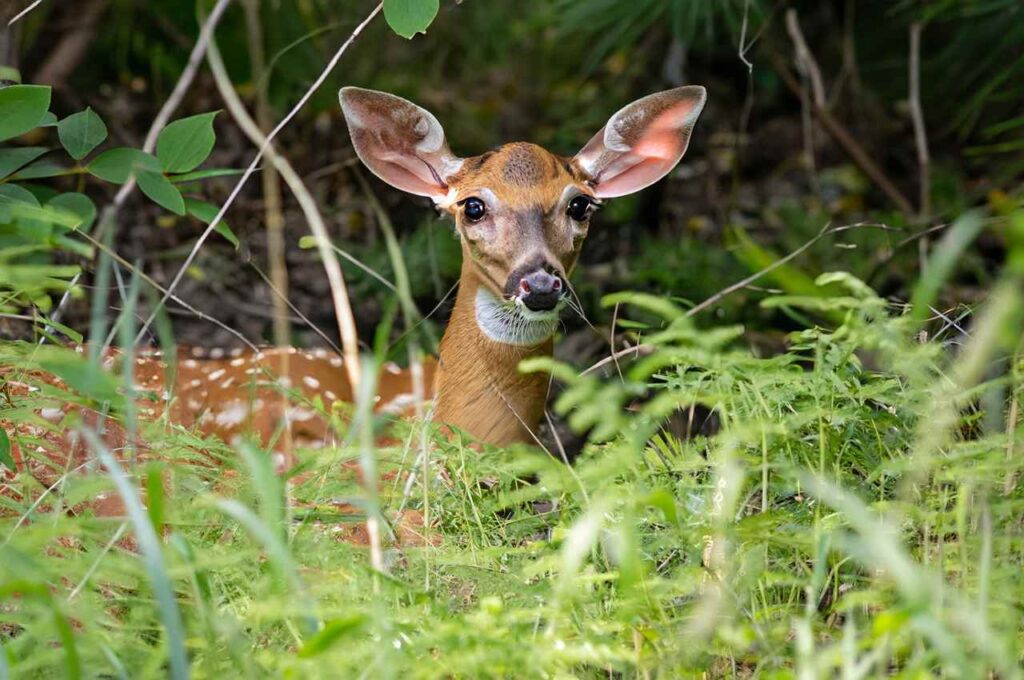
The fawn will spend almost all of the first week, known as the “bedding” period, by itself, concealed in thick grass or bushes. Only a few times a day does the mother come back to feed the fawn before departing once again. Even when other animals or people are around, fawns will remain still. They are kept hidden by this camouflage.
Development stages for fawns
The first eight weeks of a fawn’s life are divided into behavioral phases:
Bedding Stage (0-2 weeks)
Fawns spend almost all of their time by themselves under dense cover. Only briefly, the doe comes to nurse.
Flushing Phase (2-8 weeks)
Although it begins to move more, the fawn still spends the most of its time alone in bed. If frightened, it will flee (“flush”) and bleat loudly. The doe starts coming more often.
Active Phase (8+ weeks)
Fawns progressively join the herd after spending all of their time with the doe. Their camouflage coat begins to take on the reddish tint of an adult deer.
| Fawn Development Phase | Description |
|---|---|
| Bed Phase (May – June) | Newborn fawns spend most of their time bedded alone on the ground, visited briefly by the mother. |
| Flush Phase (May – June) | Fawns remain hidden but may quickly move to new hiding spots when threatened. |
| Active Phase (July – August) | Fawns become stronger and explore their environment, spending more time with their mothers. |
Factors Influencing Fawn Survival
| Factor | Description |
|---|---|
| Age of the Fawn | Younger fawns require more care and are more vulnerable. |
| Availability of Food | Adequate food sources are essential for fawn survival. |
| Presence of Predators | The risk of predation is higher for fawns without mothers. |
| Human or Pet Odors | Mother deer may avoid fawns with foreign scents. |
Should You Intervene if You Find a Lone Fawn?
A fawn should ideally not be handled or moved. You may contact a wildlife rehabilitator if it seems unwell or is wailing nonstop. Otherwise, keep a distance and watch it. Most likely, the mother is still taking care of it. Even if you remove a healthy fawn, it has a lower chance of surviving, despite your best efforts.
Our innate need to defend an isolated, helpless-appearing baby deer in the woods is sparked. However, its mother has not left it. She hides her fawn on purpose to keep it secure. She will obediently come back to take care of and rear her fawn if given the opportunity. Although the strategies deer employ to rejoin may seem puzzling, the attachment between a doe and her youngster is strong and unbreakable.
Field Insights: Navigating the World of Mother Deer and Fawn Reunions
Although mother deer and fawn reunions are a lovely and touching sight, they may sometimes be tricky to negotiate. As a human witness, it is crucial to show the deer respect and refrain from getting in the way of their reunion.
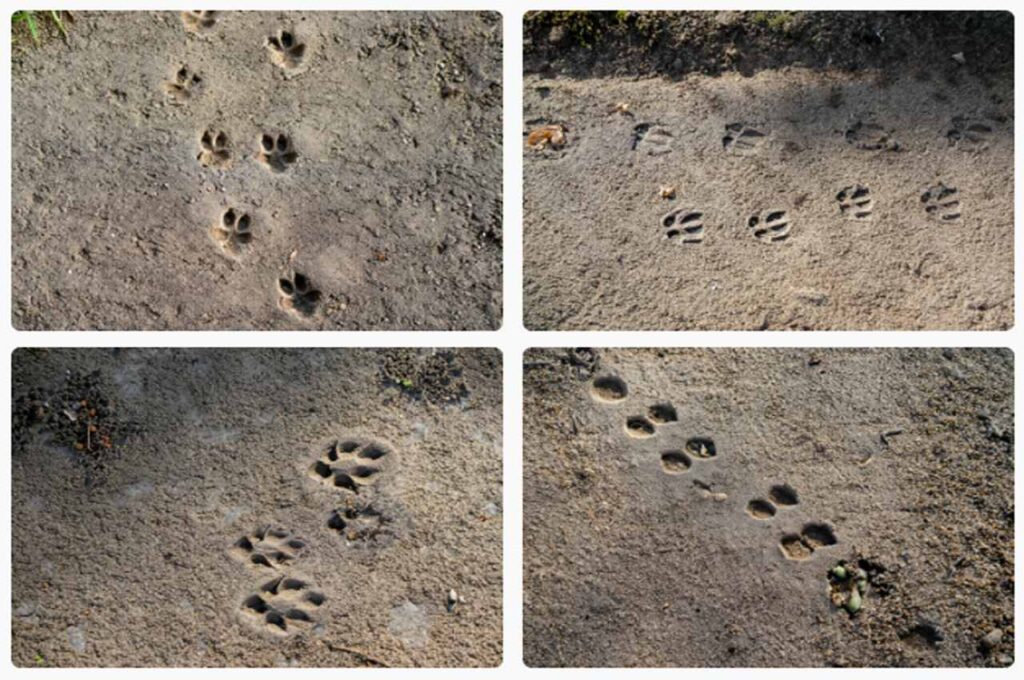
Here are some practical tips for negotiating the realm of mother-fawn reunions in deer:
- Pay attention to your surroundings. It’s crucial to be aware of your surroundings and create noise to prevent frightening mother deer and fawns since they are often quite reclusive and timid.
- Maintain your distance. Keep your distance and avoid getting too near to mother deer and fawns since they need their space.
- Have patience. Be patient and give a mother deer and fawn their space since it could take some time for them to get back together.
- Avoid touching a fawn if you see one by itself. It’s preferable to leave a fawn alone if you see one. When she’s ready, the mother deer, who may be nearby, will go back to her fawn.
- If a fawn has your attention, get in touch with a wildlife rehabilitator. You may seek help from a wildlife rehabilitator if you are worried about a fawn’s welfare.
Frequently Asked Questions
How do mother deer locate their fawns if they can't distinguish their cries?

Mother deer use a variety of techniques to find their fawns. They depend on other senses and behaviors since they are unable to discriminate between their own fawn’s unique calls. The mother first conceals her young in a quiet area, and the fawn doesn’t say anything. The mother utilizes her excellent sense of smell to find her young when she returns to breastfeed or move the fawn to a new hiding location. The mother looks for her own fragrance that she may have left in the hiding spot since fawns do not have a distinctive scent. Mother deer can distinguish their young without just depending on auditory signals because to the distinctive body movements and behaviors they exhibit.
Will a mother deer find its baby?
Yes, if a mother deer is left alone with her young in a field, garden, or backyard, she will usually locate them. Mother deer often leave their fawns alone for extended periods of time, only coming back sometimes to feed them while the fawns are concealed. It’s important not to bother a fawn if you come across one in this circumstance. Instead, keep an eye on it remotely for 24 hours since the mother will probably come back and move the fawn. However, it’s best to get in touch with a wildlife rehabilitator for help if the fawn hasn’t moved beyond this point, seems wounded, cries, or wanders aimlessly. The majority of the time, letting nature take its course and letting the mother deer take care of her young is the best course of action.
How do mother deer move their fawns?
After giving birth, mothers of deer transfer their fawns by first bringing them into a quiet area of their usual home range. The mother doe abandons her twin fawns, which may be up to 200 feet apart, for lengthy periods of time before returning to feed them and move them to new, isolated locations. This trend lasts for three weeks at most. At dawn and dusk, does mostly come back to their fawns to eat and move about. If the fawn wanders off, the mother may find it by smelling it, and fawns bleat to the mother to get her attention. Fawns are often abandoned in regions with dense grass or shrubs, however they sometimes turn up in more open areas, such backyards. Fawns spend a lot of time away from their moms during their first few months since they aren’t yet big enough to fight off possible predators drawn to the mother’s smell.
How long will a mother deer look for her baby?
To deter predators and search for food, a mother deer may leave her young alone for prolonged periods of time, often up to 12 hours. This conduct lasts for three weeks or more. The mother deer visits the area during this time to feed her young and move it to new, isolated habitats. At dawn and dusk, does return to their fawns for eating and exercise, and if the young wanders off, they may find it by smell. The mother is constantly within hearing range, and fawns may bleat to summon her. This behavior is a survival tactic since a fawn’s smell glands are still developing, making it difficult for it to defend itself. A mother deer will often rush to the rescue of her offspring if she hears it screaming nearby, protecting the fawn.
Can a mother deer smell her baby?
Despite the fact that a mother deer can smell her young, newborn fawns have no distinctive aroma. Mother deer largely use other techniques, such as voice signals, body language, and chemical communication, to find their fawns. They recall where they last concealed their fawn while looking for food. A mother deer and her offspring have a strong attachment, and the presence of human or pet scents on the fawn does not stop the mother from taking care of it. The mother deer can locate and care for her young successfully because to her multifaceted communication and maternal instinct.
Can a fawn survive without its mother?
A fawn can live without its mother, but how well it does depends on how old it is. Fawns are usually able to survive when they are 45 to 60 days old, while they still benefit from extra learning opportunities with their moms. It’s crucial to remember that a fawn’s survival rate is lower without its mother than it is with her. A fawn’s mother’s nurturing is what gives it the greatest chance of surviving. A lone fawn is sometimes mistaken for an orphan, leading to well-intentioned human intervention that occasionally does more damage than good. As a result, it is usually advisable to leave the fawn alone since even the majority of orphaned fawns are prepared to live without help from humans.
Why do deer hide their babies?
In order to protect them from predators, mother deer conceal their young. When a mother deer (doe) gives birth to fawns, she guides them into isolated locations within her home range and leaves them there for lengthy periods of time so they may go foraging for food. Fawns can hide from predators thanks to their excellent camouflage and low odor. Fawns also have the urge to freeze in place as prospective predators approach; this trait has developed to help fawns survive. Even if they have pet or human scents on them, a mother deer won’t shun her young due to the deep attachment they have. Except in rare circumstances when the fawn has flaws that would prevent its survival, fawns are seldom abandoned. In these situations, leaving the fawn in the vicinity of where it was discovered will offer shelter and security until the commotion subsides, letting the mother to look for her lost youngster.
Will a mother deer reject a fawn?
No, if a fawn has human fragrance on it, its mother won’t reject it. Rarely are fawns abandoned, and when they are, it’s usually because of severe deformities that would make it difficult for the fawn to survive. Even if they have pet or human scents on them, a mother deer won’t shun her young due to the deep attachment they have. Fawns are often abandoned in order to keep them safe from possible predators. When prospective predators approach, fawns automatically lay motionless, which has helped them survive through time.
Do baby deer cry for their mother?
Deer calves may cry for their mothers, although it doesn’t happen often. When startled or seeking to find their mother, fawns may bleat or vocalize in a manner that sounds like sobbing. Fawns tend to refrain from vocalizing, however, since it can attract predators. A weeping fawn may be an indication that anything is wrong and the newborn needs its mother. A mother deer’s close attachment with her fawn assures that she will not shun her young even if they have pet or human scents on them. Except in rare circumstances when the fawn has flaws that would prevent its survival, fawns are seldom abandoned. It may be prudent to see a wildlife rehabilitator for guidance if you come across a weeping fawn to decide whether or not intervention is required.
How long can a fawn go without milk?
A fawn is reliant on milk for the first five weeks or so of its existence, but beyond that point, provided there is enough food, water, and no other dangers, it can live without milk. Fawns can survive without milk for a short while, but in order to flourish, they usually need to be nursed every few hours. They consume a lot of milk each day—between 10 and 20 percent of their total weight. Fawns should be fed goat’s milk or a substitute milk since cow’s milk might be difficult for them to digest. Fawns may be completely weaned and independent of milk by the time they are 10 weeks old, though does often wean them between 12 and 16 weeks.
Do baby deer wait for their mother?
Baby deer aren’t left alone when their moms go to feed; instead, they wait for their mother instead. In order to avoid attracting predators to their young, mother deer purposefully ignore their fawns. Fawns are usually left in places with a lot of grass or shrubs, and they are seldom left behind unless they have severe conditions or flaws that would make them incapable of surviving. A wildlife rehabilitator should be consulted for guidance in such situations since a fawn’s weeping may be a sign that anything is wrong.
How can you tell if a fawn is male or female?
so might be difficult to tell a fawn’s gender, but there are a few ways to accomplish so. A hair-covered penile sheath, which only exists in male deer and may be seen at a young age, can be found. Another sign is the presence of antler pedicles, which are slightly above the eyes but do not yet have completely grown antlers in a newborn. The most straightforward approach is to look between the fawn’s legs. Male fawns tend to make more noise than female fawns, thus listening to vocalization may also be useful. A fawn’s back spot pattern does not distinguish between males and females; it is the same.
Conclusion
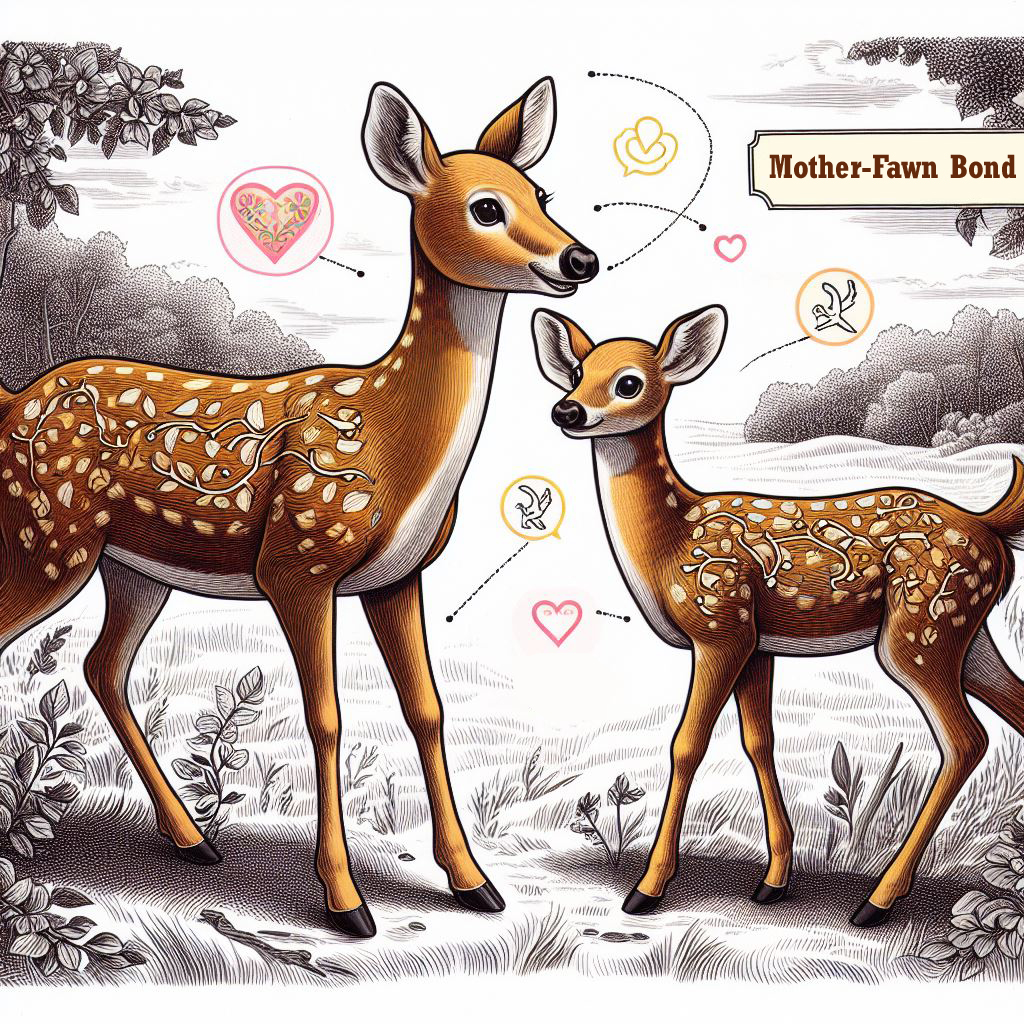
Despite leaving her fawn alone for extended periods of time after birth on purpose, a doe has a strong bond with her young. Mother deer are exceptionally adept at finding their hiding fawns using memory, sight, hearing, and smell. People shouldn’t inadvertently interfere when they come across a fawn that seems to be abandoned by understanding the developmental phases of fawns and the protective reasons why fawns do not leave their fawns alone. What could seem to be an indication of desertion is really a survival tactic. The doe will always locate her young because of the maternal link between deer. This makes sure the fawn gets the food and instruction it needs to develop into a strong adult deer.
- Wyoming Deer Season 2025-2026 New Schedule & Rules - 15 September 2025
- Wisconsin Deer Season 2025-2026: WI Deer Hunting Guide [Schedule, Rules, Licenses] - 15 September 2025
- West Virginia Deer Season 2025-2026 Complete Date & Guide - 15 September 2025
